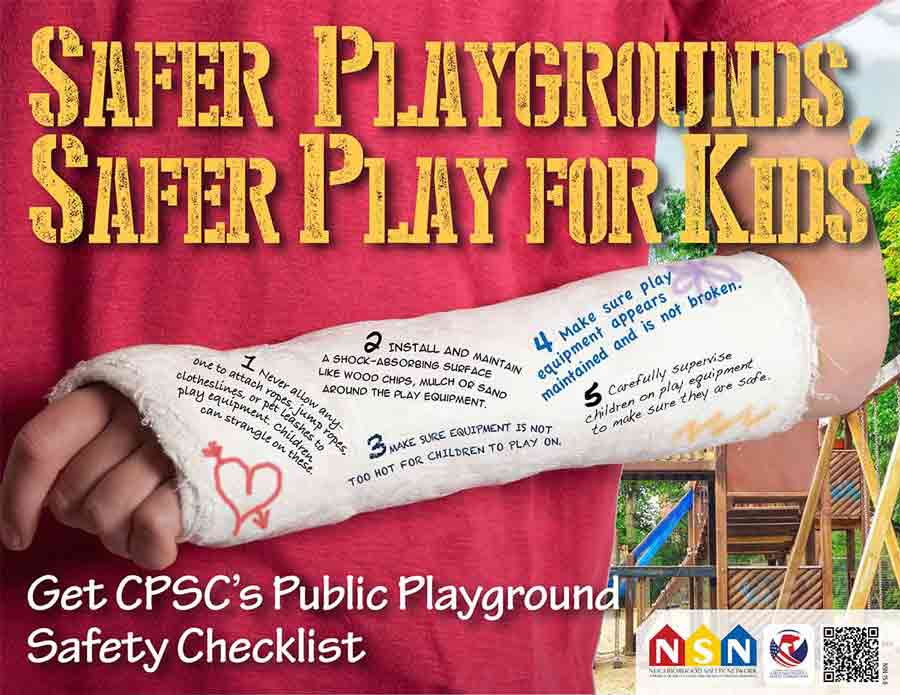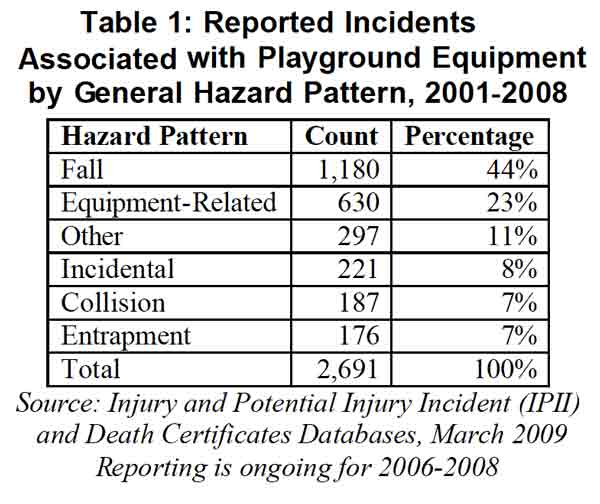
Consumer Product Safety Comission Poster (a)
About 20 children die every day from a preventable injury – more than die from all diseases combined.1 Playground injuries are one segment of these preventable injuries.
“Today we recognize that these injuries, like the diseases that once killed children, are predictable, preventable and controllable.” Grant Baldwin, Ph.D., MPH, Director, Division of Unintentional Injury Prevention, National Center for Injury Prevention and Control, Centers for Disease Control and Prevention (CDC) 2
Playground Injuries3
 From 2001-2008, an estimated 1,786,008 injuries associated with playground equipment were treated nationally in emergency departments. An estimated 57% occurred at schools or parks. Children between 5 and 9 years of age were 53% of the total injured. The top diagnoses were fractures, contusions and abrasions, lacerations and strains and sprains. The majority of the injuries were associated with monkey bars or playground gyms, swings and slides at a place of recreation or school.
From 2001-2008, an estimated 1,786,008 injuries associated with playground equipment were treated nationally in emergency departments. An estimated 57% occurred at schools or parks. Children between 5 and 9 years of age were 53% of the total injured. The top diagnoses were fractures, contusions and abrasions, lacerations and strains and sprains. The majority of the injuries were associated with monkey bars or playground gyms, swings and slides at a place of recreation or school.
Of those, 2,691 injuries were reported to Consumer Product Safety Comission (CPSC) staff. The most common causes for injury were falls (44%) and equipment related (23%). The top four types of equipment – swings, slides, climbers, and monkey bars – accounted for 58% of the reported incidents. Sixty-eight children were hospitalized, 100 died and 1,976 were treated and released. (Due to ongoing processing of data and other classification reasons these counts tend to be underestimates of the actual numbers of product-related deaths.)
How To Help Keep Your Children Safe On Playgrounds
Public Playground Safety4
CPSC playground guidelines for equipment, layout, materials and maintenance include:
- Protective surfacing, such as wood chips, mulch, sand, pea gravel, or mats made of safety-tested rubber or rubber-like materials covering a wide enough area beyond the equipment itself to reduce injuries from falls.
- Guardrails on elevated surfaces to prevent falls.
- Spaces that could trap children, such as openings in guardrails or between ladder rungs, should measure less than 3.5 inches or more than 9 inches.
- There should also be 9 feet of space between playground equipment and no tripping hazards.
- Qualified maintenance providers must do regular inspections of equipment and surfacing to be sure they are in good condition and have no dangerous hardware or sharp points.
Parents, teachers and trusted caregivers are essential to helping prevent injuries on the playground by supervising the children. Safe Kids Worldwide is a global organization dedicated to protecting kids from unintentional injuries, the number one cause of death to children in the United States.
Some tips to remember:5
- Remove necklaces, purses, scarves or clothing with drawstrings that can get caught on equipment and pose a strangulation hazard. Even helmets can be dangerous on a playground, so save those for bikes.
- Teach children that pushing, shoving or crowding while on the playground can be dangerous.
Falls are the most common type of playground injury, accounting for more than 75 percent of all playground-related injuries. Lack of or improper supervision is associated with approximately 45 percent of playground-related injuries. 5
Outdoor Home Playground Safety Handbook6
Each year, about 50,000 children go to U.S. hospital emergency rooms because of injuries on home playground equipment, and several children die on home playgrounds. About 80% of the injuries occur when children fall from play equipment.
If you are planning a playground or have home playground equipment, this handbook will help you keep your children safe. It is intended as guidance for homes and residential child care facilities.
It includes guidelines for planning your play area, picking the right construction materials, properly anchoring, assembling and maintaining your equipment, selecting protective surfacing and more.
Note: Schools, parks,multiple family dwellings, public child care facilities, restaurants and recreational developments, and other public use facilities should reference the Handbook for Public Playground Safety, CPSC publication #325.7
References:
1 Sleet, DA, RA Schieber, A Dellinger. Childhood injuries. The Enclyclopedia of Public Health, Vol I (Ed., L Breslow). New York: Macmillan Reference, USA 2002, pp 184-187
3 Data reported in O’Brien, C. (October 2009) Injuries and Investigated Deaths Associated with Playground Equipment, 2001-2008. Washington D.C : U.S. Consumer Product Safety Commission.
4 Consumer Product Safety Comission, Public Playground Safety Checklist
5 Safe Kids Worldwide, Playground Safety Tips.
6 U.S. Consumer Product Safety Commission, Outdoor Home Playground Safety, Publication #324, 2005.
Photo Source:
aCPSC Downloadable, Printable Poster: Safer-Playgrounds, Safer Play For Kids
